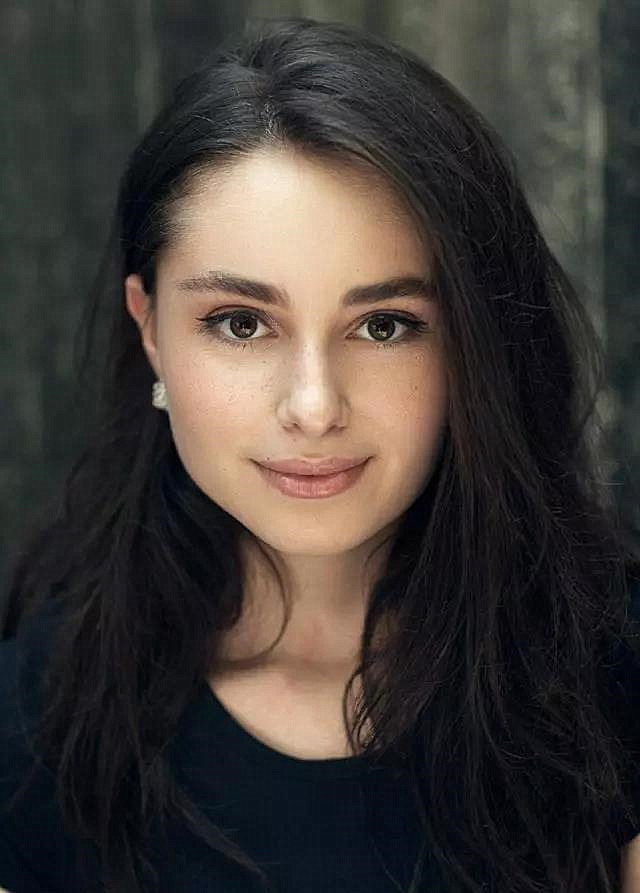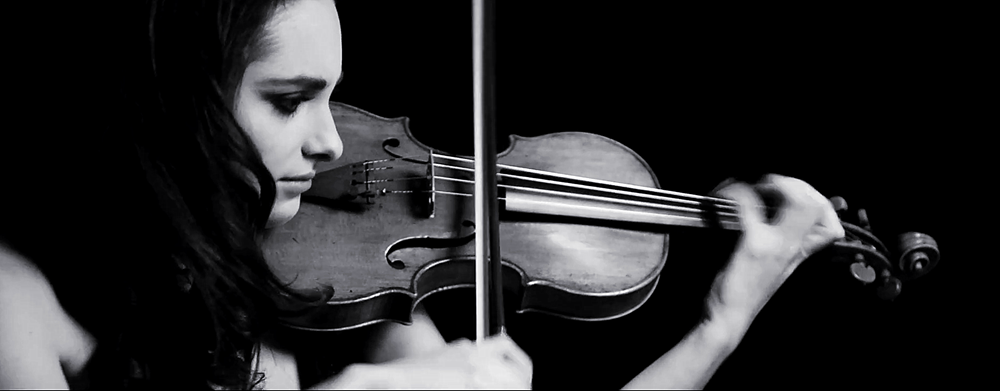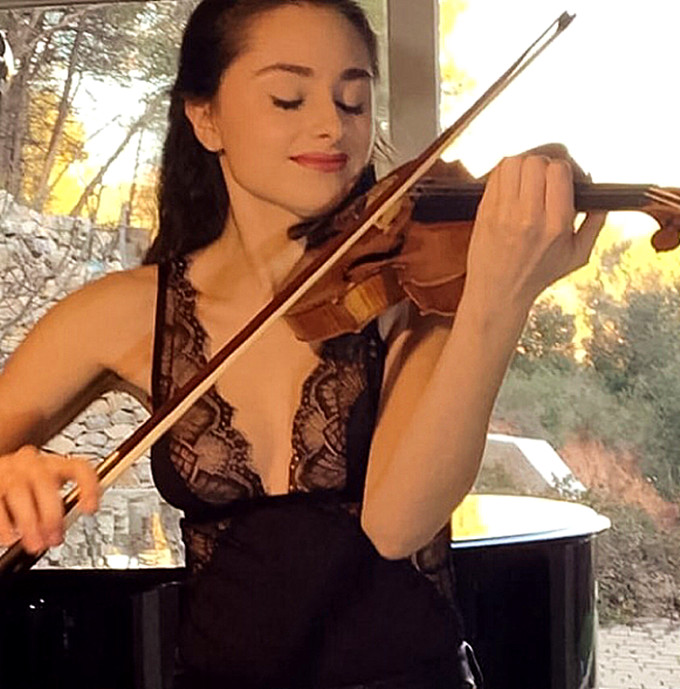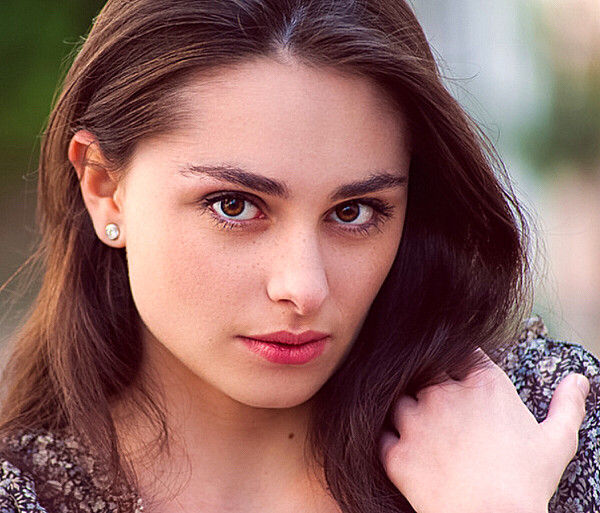| |
|
|
|
|
|
|
|
|
|
|
|
|
| |
| |
田润德 翻译整理
文/图 2017-03-14 16:26 |
|
| |
|
|
|
|
| |
 |
|
|
|
| |
艾斯特·阿布拉米
(Esther Abrami(1996~) |
|
|
|
| |
|
|
| |
阿布拉米十年漫漫学琴路 |
|
| |
|
|
|
|
| |
Artist Interview: Violinist Esther Abrami
February 7, 2017
On February 1, 2017, I interviewed violinist Esther Abrami. She was at
her home in London. I was in the San Francisco Bay Area, about 5400
miles away. I’m separating the interview into two posts and in this
first one, we cover her upbringing, her teachers, and her wonderful
violin. It was a very enjoyable conversation!
HZ: Did you grow up in a musical family?
EA: My parents love music, but I did not grow up in a musical
environment. However, my grandmother is a violinist, living in France.
HZ: How wonderful for you that your grandmother also plays the violin.
Did you see her often as you were growing up?
EA: I don’t see her very often unfortunately, but I always love calling
her and telling her all about my up coming concerts and the pieces I am
practicing.
HZ: What performances are coming up for you?
EA: I am doing some recording in the U.K. and in France. And in June, I
am going to perform Vivaldi’s Four Seasons at the Waterloo Festival,
which takes place at Saint Jones Church. In the second half of this
concert, I will lead the Blackfriars Camerata orchestra from the
concertmaster’s chair in Mendelssohn’s Scottish Symphony. The date of
the concert is June 10th.
For the Four Seasons, the date is already up on the Blackfriars Camerata
website. It will be on the 10th of June at Saint Jones Church in
Waterloo, London.
HZ: Please tell me about your violin; I understand that it was crafted
by Carlo Giuseppe Testore.
(aside) Carlo Guiseeppe Testore was born in 1625 and crafted instruments
in his workshop in Milan in the early 1700’s. Esther’s violin is more
than 300 years old.
EA: Some years ago I went to several shops, as I began to look for a new
instrument. At one of the shops I was handed an instrument, and I did
not know who the maker was. After playing this violin for two minutes, I
said to myself “This is my violin”. I found a connection with it. I have
owned it for about five years. I purchased it in Amsterdam.
HZ: From your own Web site, I learned that you participated in a Master
Class with violinist Shmuel Ashkenasi. Would you share with me and with
my readers how that experience was for you?
(aside) Shumel Ashkenasi is a music teacher I’m familiar with and have
seen his work in videos online and I was interested in how Esther’s
experience was with him.
EA: Yes… it was a 1-1 session, and it lasted about 45 minutes. He gave
me some helpful technical insights on my performance of the Faure violin
Sonata. He showed me how he would play it.
HZ: Oh, yes… teaching violin is a very complex skill. Back in the day of
Heifetz, there also was just one way of playing (the right way, the way
the teacher would play it). Later, however, things changed and as an
example, the teacher of Yitzhak Perlman, Dorothy Delay, was always
interested in how the student might bring new and exciting
interpretations to the music …
EA: Yes, exactly. My teacher now is Leonid Kerbel, and I have my violin
lessons at the Royal college of Music. We always discuss the music that
I am working on. And I find that this type of teaching can lead to my
being completely inspired.
HZ: I understand that you also have a career in modeling?
EA: I am a violinist. I am lucky to be able to do some modeling. I have
benefited from it; it helped me a lot – especially with yoga… and in
other physical ways as a violin player, with my posture, etc.
HZ: Tell me about the orchestra conductors under whose direction you
have performed?
EA: It is interesting how important a conductor is. I find that I
connect, emotionally, with what a conductor is doing, and the sections
of the music that receive their emphasis.
HZ: One of the huge
challenges for any performer is the requirement for travel. Have you had
to deal with a lot of travel so far in your career?
EA: My travel so far has been mostly in Europe, so it has been
reasonable. But I hope to come to the US next year, possibly in an
exchange program with the Manhattan School of Music.
————
In my next post of this interview with Ms Abrami we will talk about
Esther’s description of an upcoming concert in which she will perform
three compositions for violin alone. This was really interesting. The
selections she will perform are by Khachaturian, Prokofiev, and Biber.
So stay tuned to My Classical Notes for the next installment of my
enjoyable talk with Esther Abrami.
Here she is on YouTube, performing the brief and humerous Scherzo from
Beethoven’s Spring Sonata: |
|
|
|
| |
 |
|
| |
阿布拉米在演奏中 |
|
|
|
| |
艺术家访谈:小提琴家艾斯特·阿布拉米
2017年2月7日
在2017年2月1日,我在5400英里外的旧金山湾区,在伦敦的家中采访了小提琴家艾斯特·阿布拉米。我把采访分成两个部分,第一个部分中,我们介绍了她的成长过程,
第二部分介绍了她的老师和她的美妙的小提琴。这是一次非常愉快的谈话:
HZ:你是否在一个音乐家庭长大?
EA:我的父母喜欢音乐,但我没有在音乐环境中长大。然而,我的祖母是一位住在法国的小提琴手。
HZ:对于你来说,你的祖母还会拉小提琴有多棒。你长大后经常见到她吗?
EA:我不常见到她,但我总是喜欢打电话给她,告诉她所有关于我即将举行的音乐会和我正在练习的作品。
HZ:你有什么表演?
EA:我在英国和法国做一些录音。六月,我将在滑铁卢节上表演维瓦尔第的《四季》,滑铁卢节在圣琼斯教堂举行。在这场音乐会的后半段,我将在门德尔松的《苏格兰交响曲》中担任首席小提琴,带领黑修士乐团(Blackfriars
Camerata orchestra)。音乐会的日期是6月10日。
HZ:请告诉我你的小提琴;我知道它是由Carlo Giuseppe Testore制作的。
(旁白)Carlo Guiseeppe
Testore出生于1625年,1700年代早期他在米兰的工作室制作了乐器。以斯帖的小提琴已有300多年的历史。
EA:几年前,当我开始寻找新的乐器时,我去了几家商店。在其中一家商店,我拿到了一个乐器,我不知道这个制造
者是谁。演奏这首小提琴两分钟后,我对自己说:“这是我的小提琴”。我发现它有一个缘分。我拥有它约五年。我在阿姆斯特丹购买了它。
HZ:从你自己的网站上,我了解到你参加了一个小提琴手Shmuel
Ashkenasi的大师班。你愿意和我的读者分享你的经历吗?
(旁白)Shumel
Ashkenasi是一位我熟悉的音乐老师,他在网上观看过他的视频作品,我对Esther的体验与他的关系感兴趣。
EA:是的......这是1-1场比赛,持续了大约45分钟。他给了我一些关于我的Faure小提琴奏鸣曲有用的技术见解。他向我展示了他将如何演奏它。
HZ:哦,是的......教小提琴是一项非常复杂的技巧。回到海菲茨的那个时代,也只有一种演奏方式(正确的方式,老师会演奏它的方式)。但后来事情发生了变化,作为一个例子,
伊扎克·帕尔曼老师多罗茜·迪蕾总是对学生如何为音乐带来新的和令人兴奋的解释感兴趣。
EA:是的,确切的。我的老师现在是列昂尼德科贝尔,我在皇家音乐学院学习了我的小提琴课程。我们总是讨论我正在制作的音乐。我发现这种教学方式可以让我受到完全的启发。
HZ:我知道你也有模特职业?
EA:我是小提琴手。我很幸运能够做一些模特。我从中受益;它对我有很大的帮助 -
特别是在瑜伽方面......以及其他身体方面的小提琴演奏者,以及我的姿势等等。
HZ:告诉我你指挥过的管弦乐队指挥?
EA:有趣的是,指挥家是多么重要。我发现我在情感上与指挥所做的事情以及那些受到重视的音乐部分联系在一起。
HZ:任何表演者面临的巨大挑战之一就是对旅行的要求。
在职业生涯中,你是否需要处理很多旅行?
EA:到目前为止,我的旅行主要在欧洲,所以这是合理的。但我希望明年能来到美国,可能是与曼哈顿音乐学院的一个交流项目。
----
在我接下来对接受采访的阿布拉米女士说,我们会谈谈以斯她对即将到来的演唱会的描述,她将单独演奏三首小提琴作品。
这真的很有趣。 她将要表演的是哈恰图良,普罗科菲耶夫和巴伯的作品。
所以请继续关注我的经典笔记,以便能听到我和阿布拉米的下一段愉快的谈话。
在这里,她在YouTube上演奏贝多芬春季奏鸣曲中的简短而铿锵的谐谑曲:
|
|
|
|
| |
|
| |
 |
|
|
|
| |
艾斯特·阿布拉米在演奏中 |
|
|
|
| |
 |
|
|
|
| |
艾斯特·阿布拉米个人资料 |
|
|
|
| |
Born
in France in 1996, Esther graduated from the Aix-en-
Provence Conservatoire at the age of 13. She
continued her studies at Chetham’s School of Music
in Manchester where she studied with Jan Repko. In
2015, Esther began her undergraduate degree at the
Royal College of Music in London, studying with
Leonid Kerbel.
Esther recently took part in masterclasses with
musicians such as Shmuel Ashkenasi, Lewis Kaplan and
Charlie Siem.
She gave a recital at the British Embassy in Paris,
at the annual Rotary charity concert and was awarded
the first price at the Vatelot Rampal violin
competition as well as receiving the Honorable
mention at the Rising stars Grandprix competition in
Germany.
As a chamber musician Esther is part of a quartet
that has been invited to the Wigmore Hall Learning
National Young String Quartet Weekend. |
|
艾斯特·阿布拉米1996年出生于法国,13岁毕业于普罗旺斯地区艾克斯音乐学院。她继续在曼彻斯特Chetham音乐学院学习,并在Jan
Repko学习。 2015年,Esther开始了她在伦敦皇家音乐学院的学士学位,并与Leonid Kerbel一起学习。
艾斯特最近参加了音乐家大师班,如Shmuel Ashkenasi,Lewis Kaplan和Charlie Siem。
她在英国驻巴黎大使馆举行了一场独奏音乐会,参加了一年一度的扶轮社慈善音乐会,并在Vatelot
Rampal小提琴比赛中获得第一名,并在德国新星Grandprix比赛中获得荣誉奖。
作为一个室内音乐家,艾斯特是四重奏的成员之一,周末已被邀请到威格莫尔音乐厅学习国家青少年弦乐四重奏。 |
|
| |
|
|
|
|
| |
未得原作者编者授权严禁转载www.mt77.com任何内容 |
|
|
|
|
|
|
|
|
|
|
|
|
|
|
.png)

